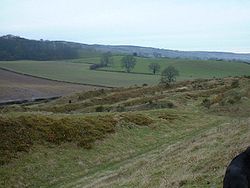- Old Oswestry
-
Old Oswestry is a large and impressive early Iron Age hill fort in the Welsh Marches near Oswestry in north west Shropshire.
It was designated as a scheduled monument (number 27556) in 1997 and is now in the guardianship of English Heritage. After the hillfort was abandoned it was incorporated into Wat's Dyke, and two sections this are adjacent to it.
Contents
Iron Age Hillfort
It was occupied between the sixth century BC and the Roman conquest of Roman Britain, probably by the Cornovii tribe.
Several phases
The complexity of its defences suggests several phases of development. The site was originally occupied by a few undefended round huts. These were then enclosed by a double bank and ditch enclosure spreading over 52,000 square metres (1.3 acres). Entrances were placed through the enclosure at the east and west ends where the inner bank was pulled back inwards to create a more impressive gateway. These defences were later rebuilt and a third bank added on all sides except the south east where the hill's steep slope made further strengthening unnecessary. The western entrance was then remodelled with unusual rectangular hollows separated by ridges dug out and defended by outworks. Finally two further circuits of banks and ditches were added to the outside and a flanking bank placed alongside the eastern entrance.
Although Old Oswestry was one of the most strongly defended hill forts in Britain there is no evidence that the Roman Legions ever tried to besiege it.
During the First World War it was used as a training area for Canadian troops. Many of the large pits and trenches shown on aerial photographs relate to these military activities. [1] [2]
References
- ^ http://www.pastscape.org.uk/hob.aspx?hob_id=66112
- ^ http://www.english-heritage.org.uk/publications/marches-uplands-mapping-project-nmp Marches Uplands Mapping Project
External links
- Ancient Britain - Old Oswestry
- Images and description of Old Oswestry[where?]
- www.geograph.co.uk : photos of Old Oswestry and surrounding area today
- History and research into Old Oswestry: English Heritage
- Map sources for Old Oswestry
Categories:- Buildings and structures in Shropshire
- Visitor attractions in Shropshire
- Hill forts in Shropshire
- English Heritage sites in Shropshire
- Oswestry
Wikimedia Foundation. 2010.

